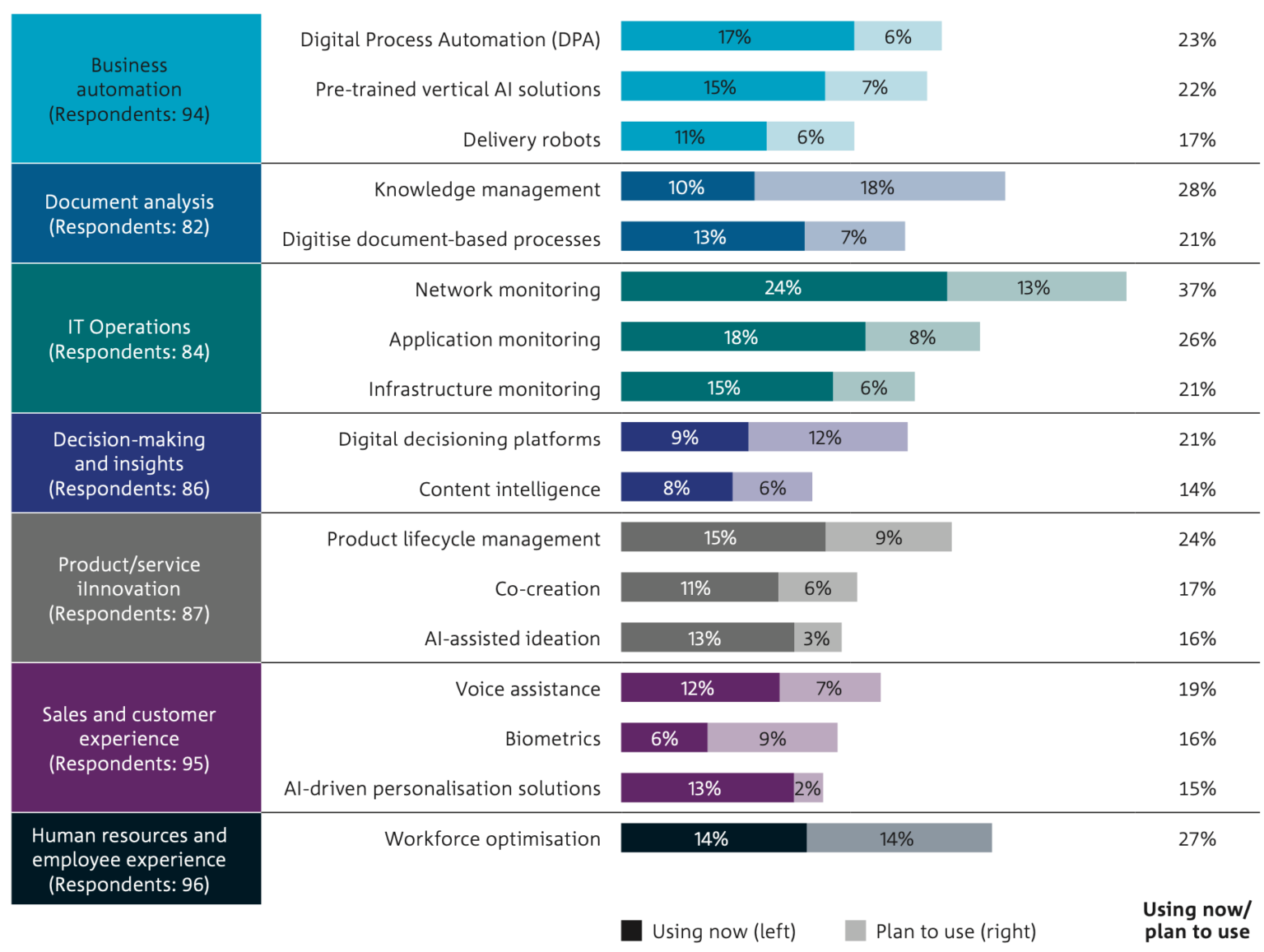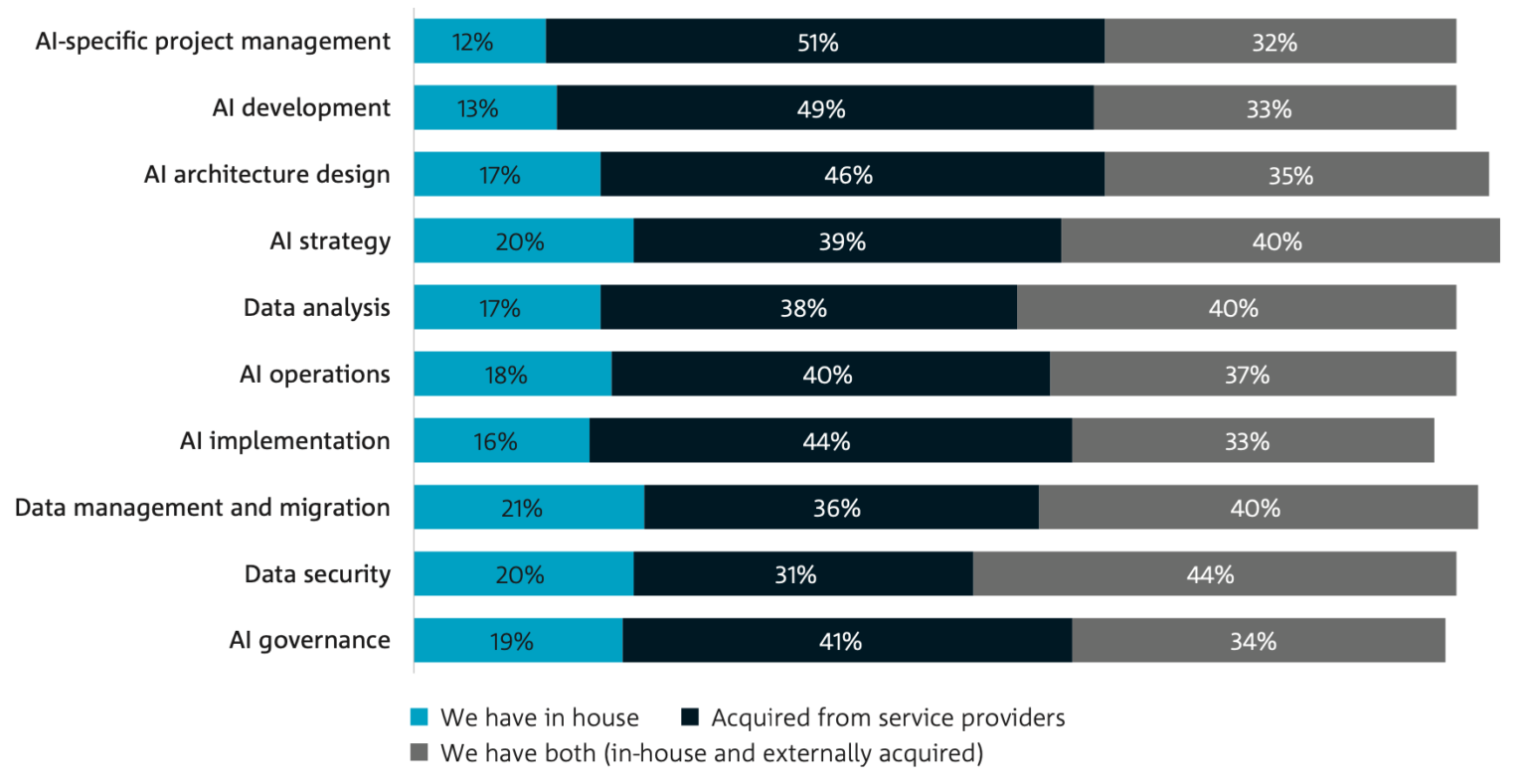Introduction
The good folks at the National AI Centre (NAIC) have recently conducted a survey of business leaders and AI specialists to help provide an assessment of Australia’s growing AI ecosystem. There were 200 participants, who completed online questionnaires and qualitative interviews in the hope to improve the region’s industry competitiveness and address some of the current shortcomings observed in the market.
Australian businesses are well aware of the strategic benefits of using AI to advance their business goals. The demand to develop highly differentiable and adaptable AI services has provided the impetus for firms to achieve AI maturity and 60% of respondents were looking to expand their capabilities.
There is momentum in Australia’s commercial sector to adopt AI led initiatives
The use of AI is multi-faceted. Operational efficiency, knowledge management, product innovation and cyber-security are just some of the typical use cases. There are also improvements to be made in employee experience, where the automation of routine parts of the role can free up time to focus on objectives that are more value-oriented in nature. This also applies to customer experience, where AI is seen as crucial in achieving growth targets set out by businesses.

Figure 1: Current and future AI-related use cases to support organisational initiatives (NAIC report)
The hope of AI is to align multiple business objectives into one overarching strategy. The jewel in the crown is the ability to provide cross-functional linkages between many departments and produce data-driven solutions that are grounded by sound AI principles. Improved revenue, security and safety are typical benefits experienced by those who implement AI.
Implementing AI is complex. A multi-disciplinary team of partners is often required to develop initiatives and often, those skills are hard to source
Organisations require specialties in AI software development, governance and data science resourcing. AI providers often provide much of this legwork, where on average, four different partners are engaged. The top three skills outsourced are AI project management, development and architectural design and the benefits are clear to see. Such initiatives saw average time savings of 30% within internal processes and an increase of $360k in added revenue.
However, there are still frictions in the marketplace. Businesses can find it difficult to find suitable partnerships that can promise a full end-to-end service, which often forces organisations to develop their own in-house capabilities, particularly in AI strategy, analysis and operational capacity. This may point to a lack of maturity in the Australian AI ecosystem, where providers often operate as siloed industry networks, academic bodies, or as niche providers of specialist skills. Businesses are instead looking for services that can combine both conceptual thinking and technical expertise into one comprehensive offering.

Figure 2: Source of AI skills to deliver AI projects (NAIC report)
In addition, there are talent shortages in Australia, which can often lead to a lack of business trust in AI solutions. This only serves to amplify the concerns around privacy, security and data quality, which have been observed as significant impediments to AI adoption. Business leaders acutely struggle with sourcing AI management, training and governance resources, however the need for these skill-sets, amongst others, will continue to grow. Access to training datasets, off-the-shelf solutions and expertise in AI component integration are again capabilities that providers must be able to provide.
AI is yielding promising results, however organisations must be prepared to invest in the technology
A strong track record of AI delivery and well presented case studies can provide the assurances needed to secure a partnership with business. Whether the strategy is to focus in on particular business areas, or operationalise across the firm, using either pre-configured or bespoke solutions, a clear return-on-investment must be communicated from the onset.

Figure 3: Top 5 benefits organisations experience when using AI technologies (NAIC report)
Governance and data management capabilities are also highly sought after skills, yet remain scarce. Building responsible AI will become a priority for many organisations, especially in regulated industries where explainability, fairness and accountability are compulsory requirements. Providers who can help build out an organisation’s internal capabilities and provide support throughout the AI development lifecycle, are sure to do well. Investments in data profiling, data discovery and synthetic data will only further help the adoption of AI in future business proposals.
A case study from Mantel Group
Here at Mantel Group, we have worked with organisations big and small to deliver AI at all stages of the product life cycle. It’s our bread and butter. A customer of ours from one of the Big 4 Australian banks was looking to develop the ability to productionise machine learning models and use AI as part of their decision making. They had a modest data science department and ample access to data, however they lacked the capability to string it all together. We find that this is a very common experience amongst our clients.
We worked across the organisation to architect a new cloud data platform and developed an MLOps lifecycle that would allow the team to create and manage multiple AI workflows. Up-skilling and training was an important part of the initiative, which enabled the team to become more comfortable with implementing permission-driven controls and maintaining governance procedures across the organisation.
As part of the strategic vision, a new data science workbench was established and gave data scientists the set of tools required to work consistently and reliably. We helped develop data pipelines for training and inference, implemented API layers for model access and created a decision layer, so that actionable insights could then be generated. The key deliverable was unification of the data platform across the bank, so that all stakeholders could work in tandem to interact with, build and explore AI solutions in a secure manner.
The result led to many use cases within the organisation, including generating insights to improve customer engagement, using speech-to-text services to maintain quality control in complaints procedures and forecasting economic outlooks from internal indicators. The new AI framework added significant value to the organisation and the team were emboldened to develop products that were adaptable to changing business requirements and market demands.
We love interesting problems. If you would like to see how data can work for you, feel free to reach out for a no-obligation chat today!